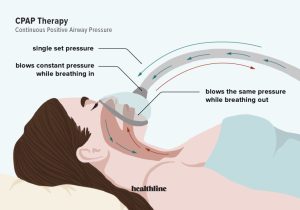CENTRAL POSITIVE AIRWAY PRESSURE CPAP
CPAP is a machine with a compressor that generates a continuous stream of pressurized air that travels through an air filter into a flexible tube. This tube delivers purified air into a mask that is sealed around the patient’s nose or mouth. As the patient sleeps, the airstream from the CPAP machine pushes against any blockages, opening the airways so that the lungs can receive plenty of oxygen, therefore reducing episodes of sleep apnea. There are different types of CPAP machines that have similar functions. These include CPAP (central positive airway pressure), APAP (automatic positive airway pressure), and BiPAP (bi-level positive airway pressure).
CPAP devices deliver a constant preset pressure and can only be changed by resetting the device settings. APAP devices will check the patient’s breathing throughout the night and adjust the air pressure delivered to compensate for breathing changes. BiPAP devices have a set pressure for inhaling and a lower pressure for exhaling, which can help patients who can’t tolerate traditional CPAP, have high carbon dioxide levels, or need help maintaining respiratory rate, like patients with central sleep apnea, where the brain is not signaling the patient to breathe.
